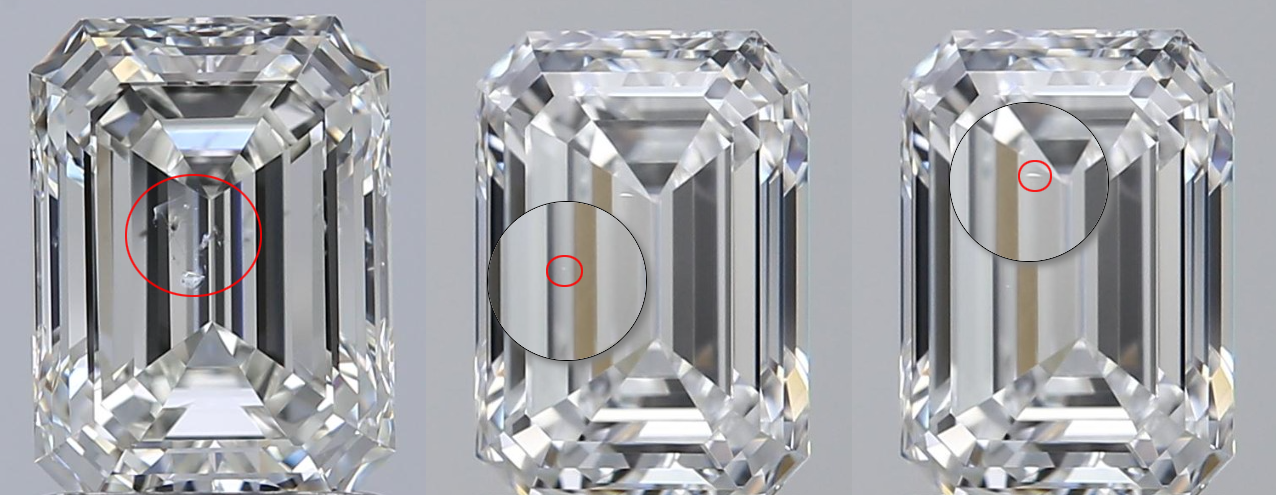Blog archive
Diamond Inclusions – 3 Benefits You May Have Overlooked

Today we take a look at what some see as the scary side of diamond buying, and shed some light on how to navigate flaws, blemishes, and those beauty marks we call inclusions. Continue reading to see what our certified diamonds experts have to say!
To most people, a diamond’s characteristics or imperfections, referred to as inclusions, are something to be avoided. The truth however is that unless the person you’re buying for is a particularly big spender after a flawless diamond, these imperfections are just a fact of life. Furthermore, there may be reasons to SEEK OUT inclusions. Let’s take a look at why:
Inclusions are one of the main five factors when determining the clarity grade of a diamond, the others being size, position, number, nature, and colour or relief. Beyond this, however, inclusions play a much wider role. A diamond’s unique imperfections serve as great identifiers, and just like fingerprints or snowflakes, this means no two diamonds are ever exactly alike. Get to know your inclusions, and you’ll recognise & know your diamond on a whole different level.
Another often overlooked benefit of inclusions, and one appreciated by trained gemmologists, is that inclusions in natural diamonds differ from those in lab-grown diamonds. As a result, these can be used to conclusively prove if a diamond is of natural origin.
After you’ve started to familiarise yourself with the most frequent diamond inclusions, you’ll grow to have a better understanding of diamond grading reports in general.
Below we’ve listed the most common inclusions found in diamonds, and the key things to note about each.
Pinpoints and Clouds
As small as a speck of dust, a pinpoint is a teensy mineral crystal (sometimes even a tiny diamond crystal within the diamond) that can hide, even under magnification, from trained specialists. When you have multiple in a cluster, this is known as a group of pinpoints. If even these clusters are so small that they only appear as a somewhat hazy form, this is called a cloud.
Crystal, Needle, Knot, or Dark Crystal
When referring to inclusions, a crystal is a diamond or other mineral present in its natural & raw crystal form, embedded into the stone. You can also have dark crystals, which have a medium or dark tone to them. Needles are similar inclusions but instead are long, narrow & rod-shaped crystals. Knots, similar to knots in wood grain, are crystals that reach the diamond’s outermost surface area. These crystals can be particularly beautiful on rare occasions on which they take the form of bumblebees or a heart shape. They are commonly colourless or a shade of white, but have been known to be a multitude of colours including red, green, grey, and black. Don’t think of them as imperfections, but instead as free gemstones within your diamond at no added cost!
Feather and Cleavage
A feather or cleavage, just like a geological chasm in microscopic size, is a void or separated plane within the internal structure of the diamond. These inclusions resemble real feathers quite closely and hence the name. Larger feathers may be visible to the eye in SI clarity graded diamonds, while I2 and I3 clarity diamonds often have large feathers which can cause structural integrity concerns. For this reason, many diamond retailers will not supply diamonds of these clarity grades. Stones of clarity VS and above may still have feathers, but these are of much less concern. Feathers that reach the surface are best avoided, whilst those entirely contained by the diamond are generally okay once mounted.
Internal Grain Lines and Twinning Wisps
Grain lines are usually colourless and rather subtle, and are caused by irregular growth patterns in the course of a diamond’s formation. A twinning wisp is a collection or string of small pinpoints, clouds, or crystals, often resembling a white or black stripe or a streak of fairy floss. These are formed due to an irregularity in the diamond’s crystal structure. Both can be simply regarded as a momentary but permanent snapshot of Mother Nature’s disruption, caused at a single moment in time, thousands of years ago.
Indented Natural
An indented natural inclusion is an indentation in the diamond which includes a piece of the raw diamond’s unpolished exterior. That is, it’s a part of the rough diamond untouched during the polishing process, which shows you the diamond’s original form. These are typically present around the girdle area.
Cavity
Just as its name suggests a cavity is a small and slightly deep concave area on the diamond, appearing like a crack extending inward. This is typically created in the manufacturing process, where during diamond cutting & polishing a crystal is removed. It’s sometimes judged best to remove a noticeable inclusion and instead leave behind a cavity. Cavities can also form naturally when a diamond dislodges an inclusion during its formation.
Chip
Chips and nicks are irregular openings and are often small and shallow. They are most often found on the girdle edge (the part of the diamond that distinguishes the top from the bottom), especially in instances where the girdle is too wavy or thin.
And that concludes our brief look at the various inclusions you may encounter. Be aware that diamonds graded VS and higher have a very high chance of being eye-clean, and are structurally sound. Reputable loose diamond retailers will also disclose any inclusions that impact a diamond’s clarity, and you will be able to observe any diamonds yourself prior to purchasing.



